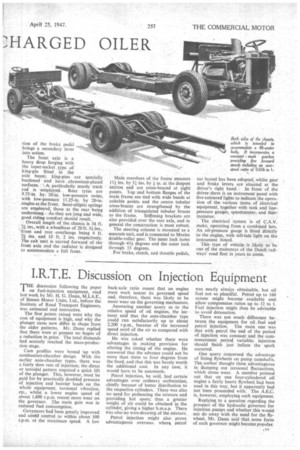I.R.T.E. Discussion on Injection Equipment
Page 45

If you've noticed an error in this article please click here to report it so we can fix it.
discussion following the paper Ton fuel-injection equipment, read last week by Mr. H. G. Dunn, 141.I.A.E., of Simms Motor Units, Ltd., before the Institute of Road Transport Engineers, was animated and instructive.
The first points raised were why the cost of equipment is high, and why the plunger cams now differ in shape from the older patterns. Mr. Dunn replied that there were at present no hopes of a reduction in price. The total demands had scarcely reached the mass-production stage.
Cam profiles were bound 'up with combustion-chamber design. With the earlier ante-chamber types, there, was a fairly slow rate of injection; the direct or toroidal pattern required a quick lift of the plunger. This, however, must be paid for by practically doubled pressure of injection and heavier loads on the whole equipment, torsional vibration. etc., whilst a lower engine speed of about 1,800 r.p.m meant more wear on the governor. The main gain was in reduced fuel consumption.
Governors had been greatly improved and could control to within about 100 r.p.m. at the maximum speed. A low back-axle ratio meant that an engine must work nearer its governed speed and, therefore, there was likely to be more wear on the governing mechanism.
Answering another query as 4o the relative speed of oil engines, the lecturer said that the ante-chamber type could run satisfactorily up to about 2,200 r.p.m.. because of the increased speed swirl of the air as compared with direct injection.
He was asked whether there were advantages in making provision for altering the timing of the engine. He answered that the advance could not be more than three to four degrees from the fixed, and that this was barely worth the additional cost. In any case, it would have to be automatic.
Petrol injection, he said, had certain advantages over ordinary carburation, chiefly because of better distribution to the respective cylinders. There was also no need for preheating the mixture and Troviding hot spots; thus a greater weight of air could be obtained in the cylinder, giving a higher b.m.e.p. There was also no wire-drawing of the mixture.
Petrol injection might also prove advantageous overseas. whera, petrol was nearly always obtainable, but oil fuel not so plentiful. Petrol up to 160 octane might become available and allow compression ratios up to 12 to 1. Fuel injection might then be advisable to avoid detonation.
There was not much difference between the equipment for oil fuel and petrol injection. The main one was that with petrol the end of the period of injection was constant and the commencement period variable; injection should finish just before the spark occurred.
One query concerned the advantage of fitting flywheels on pump camshafts. They author thought these advantageous in damping out torsional fluctuations. which cause wear. A member pointed out that on one four-cylindered oil engine a fairly heavy flywheel had been used in this way, but it apparently had not been proceeded with. The A.E.C. is, however, employing such equipment.
Replying to a question regarding the prospect of the hydraulic governor for injection pumps and whether this would not do away with the need for the flywheel, Mr. Dunn said that some form of such governor might become popular.












































































